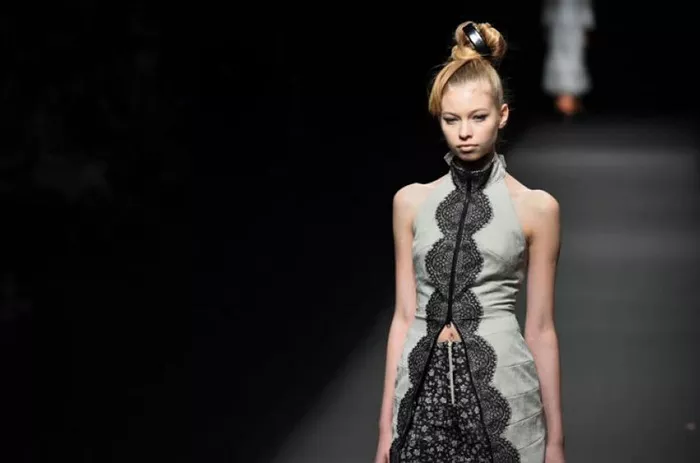This season’s Rakuten Fashion Week Tokyo unfolded with an air of celebration. The event kicked off with the 10th anniversary of the Tokyo Fashion Award, which annually selects eight Japan-based designers and offers them the chance to showcase their collections in Paris for two seasons. These designers also receive financial backing to present their work during Tokyo’s Autumn/Winter fashion week. The festivities included a packed opening party at the Omotesando Hills shopping complex, and numerous exhibitions and panel talks were held throughout the week.
Despite the celebratory atmosphere, the event was smaller in scale compared to previous seasons. This year, 34 designers were featured on the schedule, a drop from last season’s 43. Of these, 28 presented physical showcases, spread over six days. This resulted in a more focused and manageable schedule, allowing the spotlight to remain on Tokyo’s most promising talents. The compact nature of the event underscored Tokyo’s growing status as an important incubator for fashion innovation.
International Influence Slowly Expanding
Tokyo Fashion Week’s limited international presence remains a challenge. However, efforts are being made to attract more global attention. The Japan Fashion Week Organisation (JFWO) invited more foreign press this season to address the issue. Among the notable guests was Sara Sozzani Maino, a renowned talent scout and creative director of Fondazione Sozzani, who returned to Tokyo after a six-year hiatus. Maino expressed the value of experiencing Japanese fashion directly in Tokyo, rather than in other international venues.
Although the presence of international buyers remained scarce, there are indications of progress. One highlight was a collaboration with Paris-based trade show Tranoï, which opened its first Asian showroom during the event. Featuring 134 designers from Africa, Europe, and Asia, the showroom offered increased exposure to Tokyo Fashion Week’s attendees. Tranoï also hosted a midweek party, attracting over 3,500 guests, half of whom were buyers. Plans are in place to expand this partnership, with Tranoï moving to a larger venue at Yoyogi National Stadium by September 2025.
Designers themselves are also seeking ways to garner international attention. Emi Funayama, who presented one of the week’s most acclaimed shows with her brand Fetico, acknowledged the challenges of attracting overseas buyers but remains committed to expanding into broader Asian markets. Other brands, like streetwear label Kamiya, are using online platforms like Instagram to grow their international reach. Kamiya recently secured new stockists in New York and South Korea.
A Slimmer but Stronger Schedule
The decision to scale back the number of designers this season was intentional. According to Hiroshi Komoda, secretary general of JFWO, the focus has shifted from quantity to quality. Despite the smaller roster, Tokyo Fashion Week showcased a diverse range of talent, offering unique and memorable presentations.
Notable moments included a homecoming show by Teppei Fujita, designer of Sulvam and an alumnus of Yohji Yamamoto’s team, to mark the brand’s 10th anniversary. Yoshio Kubo also celebrated 20 years in the industry with a show that incorporated Japanese comedy, while Anrealage Homme closed the week with a standout presentation.
However, some designers, particularly in menswear, opted to show outside the official schedule. Brands like Irenisa and Soshiotsuki released their Spring/Summer 2025 collections in July to align with the international buying calendar. Others, like Harunobu Murata and Keisuke Yoshida, faced challenges securing venues during fashion week and chose to present their collections at different times.
Challenges with Venues
Finding suitable venues remains a challenge for designers in Tokyo. Fashion shows often face logistical difficulties due to strict regulations on venue use. Komoda acknowledges the issue, noting that unlike Paris, fashion is not yet deeply ingrained in Japan’s cultural fabric. However, efforts are being made to improve venue accessibility for future seasons.
A Strong Domestic Market
For Asian designers, Tokyo offers significant opportunities due to its robust domestic market. Brands like Seivson from Taiwan and Guangzhou-based designer Yueqi Qi have found success by presenting at Tokyo Fashion Week. Qi, whose sales have grown by 45% in Japan, cites the loyalty and understanding of her Japanese customer base as key reasons for returning to the Tokyo schedule.
Domestic buyers are also increasingly enthusiastic about Tokyo Fashion Week. Takenori Osawa, CEO of Midwest, a concept store with multiple locations in Japan, highlighted the rise of womenswear designers such as Fetico, Viviano, and Chika Kisada. Osawa noted a shift in the market, with more customers gravitating toward brands that offer a sexier aesthetic. He also pointed out that Midwest has significantly increased its stock of Japanese brands, now accounting for around 80% of the store’s offerings.
Despite challenges, Tokyo Fashion Week appears to be on an upward trajectory. While the event may lack the star power of names like Yohji Yamamoto or Undercover, the growing number of emerging designers and strong domestic support signal a bright future for the city’s fashion scene.
Related topics:
- Stray Kids’ Lee Know And Felix Made Their New York Fashion Week Debut At Tommy Hilfiger’s Spring-Summer 2025 Show
- Hilfiger Embraces Nautical Theme At Fashion Week With Runway Show On Former Staten Island Ferry
- Wu-Tang Clan Performs At Tommy Hilfiger’s New York Fashion Week Show

